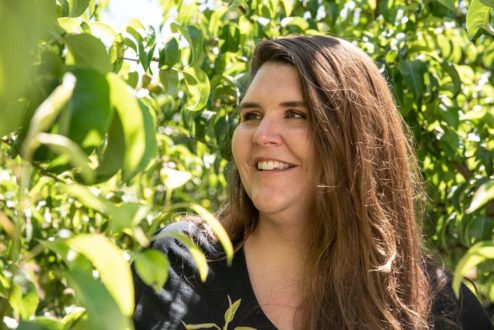Jul 9, 2020Extension helps deliver successful Oregon cherry harvest in Wasco County
The coronavirus pandemic hit just as Oregon State University Extension Service tree fruit expert Ashley Thompson was preparing for the upcoming cherry harvest. A big concern was the prevalence of X disease in cherries, which had prompted many Oregon and Washington growers to remove hundreds of valuable trees.
Suddenly, the growers had a human disease to worry about: COVID-19.
With the pandemic causing high infection rates in other agricultural regions of the Pacific Northwest, growers in Wasco County worried that their workers would be unable or unwilling to travel north from California to pick.
“There was a lot of uncertainty,” said Thompson, an assistant professor of horticulture who works with tree fruit growers in Wasco and Hood River counties.
Wasco County is one of the top cherry-growing regions in the West, and each year about 6,000 migrant workers arrive in the area in late May to bring in the Chelan, Bing and Sweetheart cherries the region is known for. The harvest runs from early June to the first or second week of July. The orchards on the hillsides overlooking the Columbia River have produced the tasty fruit for over a century.
With that harvest threatened, Thompson stepped into a new role. She became the county’s agricultural emergency response coordinator. Her colleagues at Wasco Extension – Lynette Black and Lauren Kraemer – also stepped in to help.
Thompson surveyed growers to assess their needs and worked with local government officials to determine their new rules for the pandemic. She set up a webinar featuring local health officials. She began working with local nongovernment agencies that assist migrant populations. She helped farms acquire additional portable bathrooms and hand-washing stations, sourced thousands of face coverings, and advised growers on how to set up housing and isolation facilities so the workers could be cared for properly.
She also distributed posters in Spanish and English explaining social distancing, hand-washing and COVID-19 symptoms. The posters were created by Kraemer, an assistant professor of practice with the Extension Family and Community Health program. Meanwhile, Black – an Extension associate professor – served as a volunteer coordinator and helped distribute hand sanitizer, posters and masks to local growers.
As the calendar turned to May, the depth of the concern about the upcoming harvest increased. Six thousand new residents were headed toward The Dalles, and Wasco residents wanted to avoid the labor strikes and high hospitalization rates experienced by agricultural workers in Yakima, Washington, and that state’s Tri-Cities region around Richland, Pasco and Kennewick.
“We were looking at a potential human health crisis as well as an economic crisis if the cherry crop couldn’t be harvested,” Thompson said.
In May, after the Oregon Occupational Health and Safety Department came out with specific guidelines, preparations accelerated. The growers were able to secure sufficient face coverings. Many began retrofitting the workers’ living quarters, putting up sink partitions in community bathrooms, developing work protocols, and bringing in additional portable housing.
Growers learned how to tap into resources like the state Food Security & Farmworker Safety Program to help them pay for hotel rooms needed to isolate infected workers.
By the time harvesting began, Wasco County was ready. Despite some late rains that caused fruit crack in some orchards and some ongoing concerns about X disease in some cherry trees, the harvest was a great success. The price of cherries was good and the quality of the produce workers brought out of the orchards was excellent. There were a few cases of COVID-19 in The Dalles, but significant outbreaks were averted.
“I’ve been seeing a lot of happy cherry growers in the last week,” Thompson said with a relieved laugh.
Through this, Thompson has continued her work as a fruit tree horticulturist. She has several experiments running and continues to educate growers on the diseases, pests, and routine challenges of being an agricultural producer.
“The horticulture doesn’t stop, the research doesn’t stop,” Thompson said. “When the pandemic arrived, we just did what our community needed us to.”
The next big push will come August in Hood River County for the pear harvest. Hood River sees about 4,000 workers for pears. While many cherry workers bring their families, Hood River workers are Individual H-2A workers who come from foreign countries because growers can’t get enough domestic help. Oregon has established guidelines for these workers as well, such as no bunkbed accommodations and nonpermeable barriers between socially distanced beds.
“The cherry harvest was definitely a dry run for pears,” Thompson said. “We still have our work cut out for us in Hood River to make sure things go smoothly there.”
– Jim Sloan, Oregon State University
Ashley Thompson is OSU Extension’s tree fruit specialist in Wasco and Hood River counties. Photo: Stephen Ward/Oregon State University















